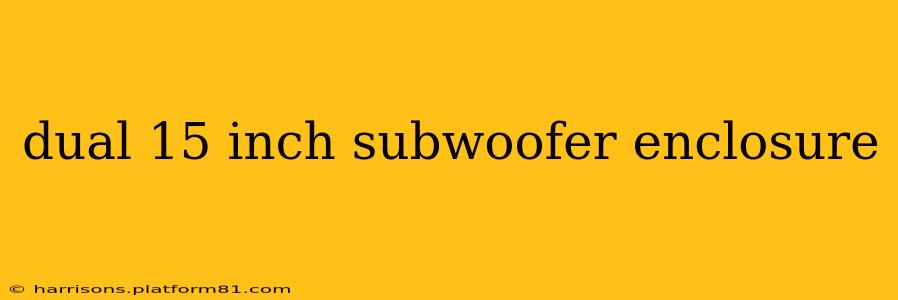Building a dual 15-inch subwoofer enclosure is a significant undertaking for any audio enthusiast. This project demands careful planning and execution to achieve the desired low-frequency impact and sonic accuracy. This guide delves into the crucial aspects of designing and building a high-performance enclosure for two 15-inch subwoofers, addressing common questions and challenges along the way.
What are the benefits of a dual 15-inch subwoofer enclosure?
A dual 15-inch subwoofer setup offers substantial advantages over single subwoofer systems. Primarily, you'll experience significantly increased output and lower distortion at the very bottom end of the frequency spectrum. Two 15-inch drivers working in unison can produce significantly more acoustic power, resulting in a more impactful and immersive listening experience, especially in larger rooms or outdoor spaces. The dual configuration also provides improved headroom, meaning the subs are less likely to clip or distort even at high volumes. This translates to a cleaner, more controlled bass response. Finally, the increased surface area of the drivers can help distribute the bass more evenly throughout the listening area, reducing localized pressure points.
What type of enclosure is best for dual 15-inch subwoofers?
The optimal enclosure type for dual 15-inch subwoofers depends largely on your desired sound characteristics and the specific subwoofers used. Popular choices include:
-
Sealed (Acoustic Suspension): Sealed enclosures are known for their tight, accurate bass response and low distortion. They're less prone to port noise and generally easier to design and build. However, they typically produce less overall output compared to ported enclosures.
-
Ported (Bass Reflex): Ported enclosures utilize a port (tube) to extend the low-frequency response, resulting in higher output at specific frequencies. They can produce louder bass, but require more careful design to avoid port noise or unwanted resonances. The port tuning frequency is crucial and needs to be matched to the subwoofer's parameters.
-
Bandpass: Bandpass designs are more complex and offer very high output within a specific frequency range. However, they are considerably more challenging to design and require precise calculations to avoid unwanted resonances and peaks. They are generally less versatile than sealed or ported enclosures.
How much power do I need for a dual 15-inch subwoofer enclosure?
The power requirements for your dual 15-inch subwoofer system depend heavily on the sensitivity and power handling capabilities of the chosen subwoofers. Consult the specifications of your selected subwoofers to determine their RMS (continuous) power rating. Your amplifier should be capable of providing at least this much power per channel to avoid overloading the drivers. Overpowering is also to be avoided as this can cause damage. It's generally recommended to have an amplifier with slightly more power than the subwoofers' RMS rating, allowing for headroom and preventing clipping. Remember that two subwoofers will demand double the amplifier power compared to a single subwoofer system.
What size enclosure do I need for dual 15-inch subwoofers?
There is no single answer to this question; the optimal enclosure volume depends entirely on the subwoofer's specifications and the chosen enclosure type (sealed, ported, bandpass). Subwoofer manufacturers often provide recommended enclosure volumes in their specifications. For ported designs, the port dimensions and tuning frequency are also critical factors. Using WinISD or similar subwoofer design software is highly recommended. These programs allow you to input the subwoofer parameters and design an enclosure that optimizes performance for your chosen design. Incorrect enclosure sizing can lead to reduced output, excessive distortion, or even damage to the subwoofers.
What materials should I use for my dual 15-inch subwoofer enclosure?
High-density materials are generally preferred for subwoofer enclosures to minimize unwanted vibrations and resonances. Common choices include:
-
Medium-Density Fiberboard (MDF): MDF is a popular choice due to its density, cost-effectiveness, and ease of working with.
-
Particle Board: Particle board can be used, but MDF generally provides superior results.
-
Plywood: While sturdy, plywood can be more challenging to work with and may require more extensive bracing to prevent vibrations.
Regardless of the material chosen, ensure the enclosure is properly braced internally to maintain rigidity and prevent panel flexing which can negatively affect sound quality.
Building a dual 15-inch subwoofer enclosure requires meticulous planning and execution. Utilizing subwoofer design software, selecting appropriate materials, and paying attention to the internal bracing are crucial for achieving optimal performance and a satisfying listening experience. Remember to always prioritize safety and consult professional advice if unsure about any aspect of the construction process.
